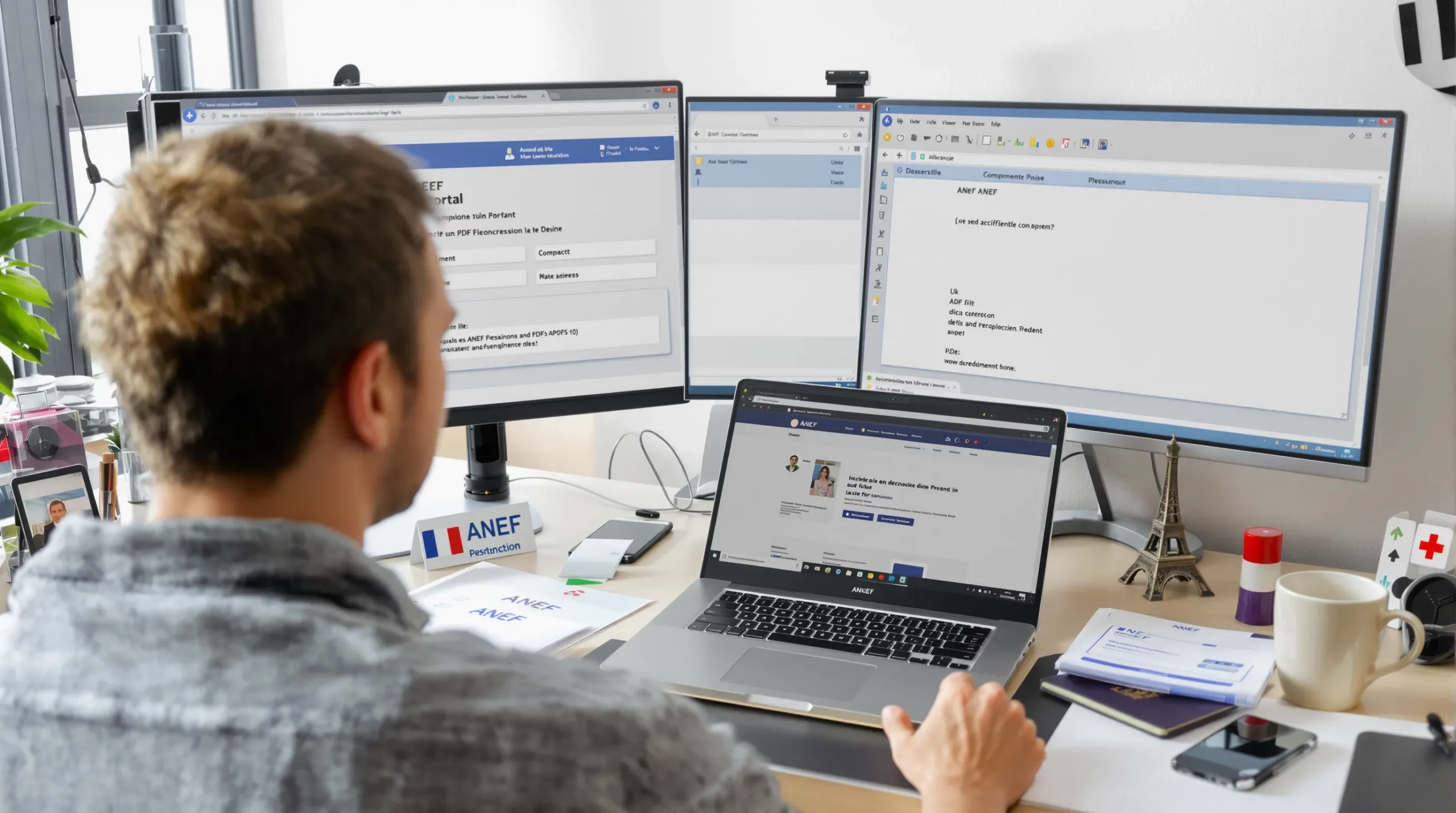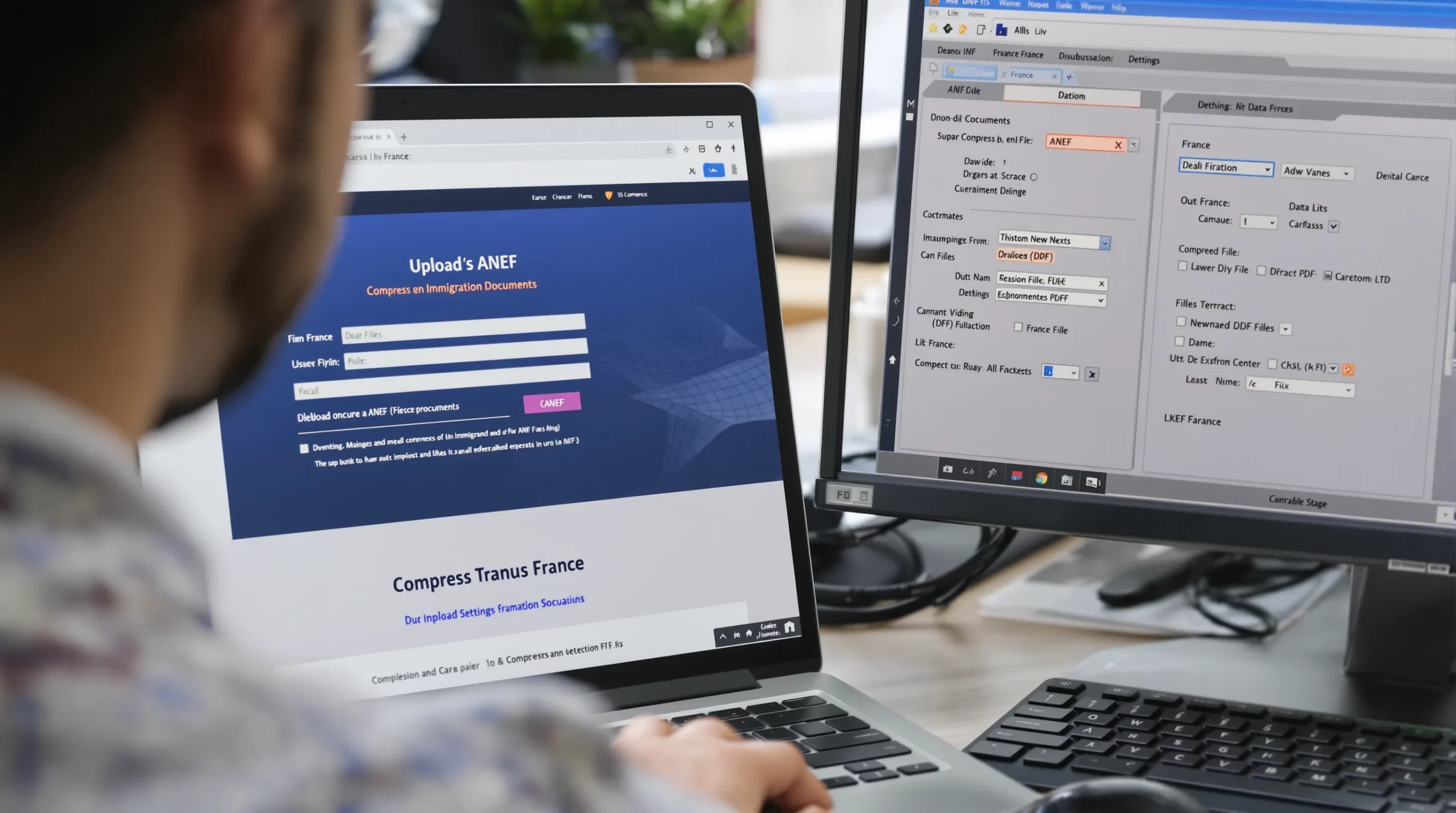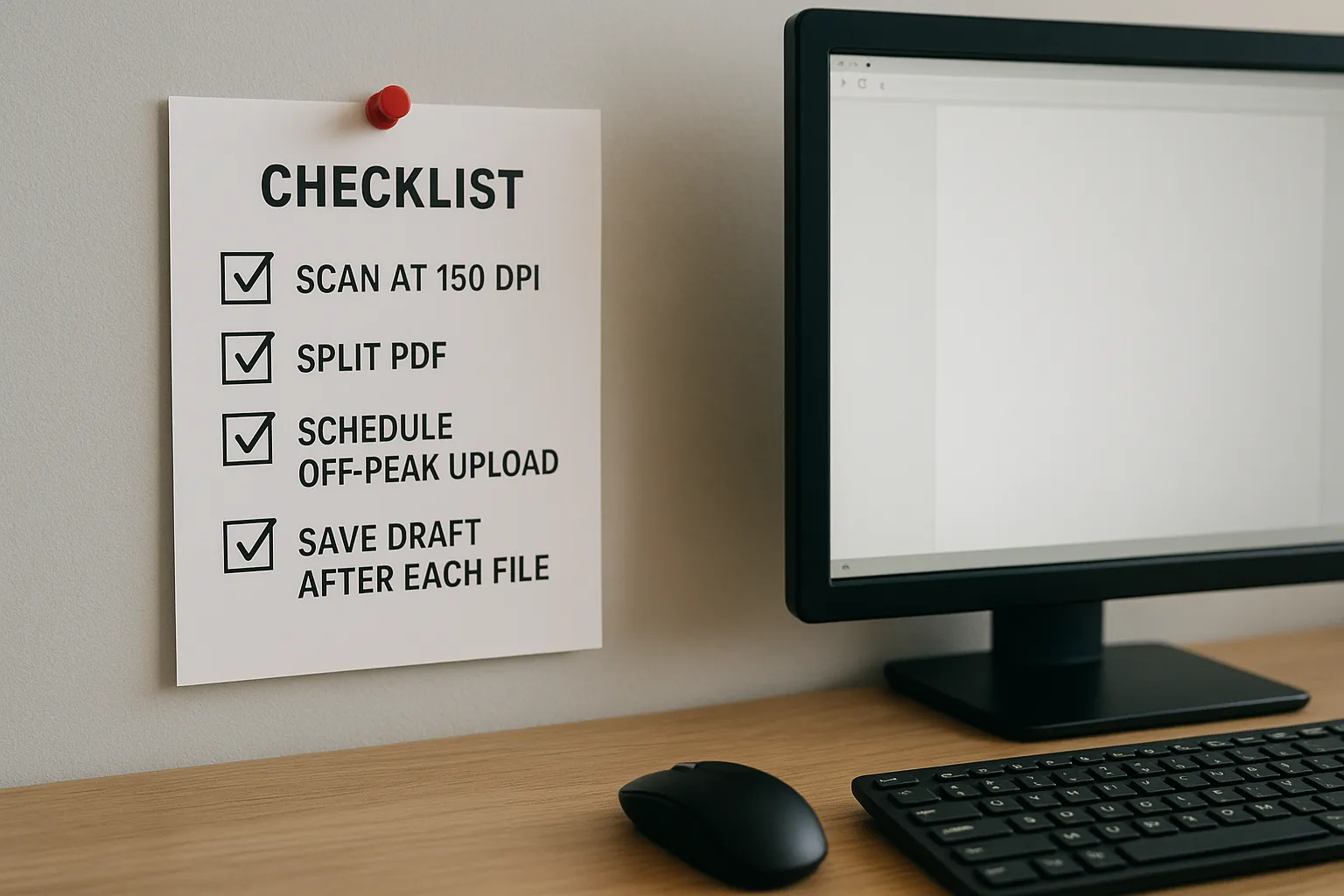How to Avoid Prefecture Portal Timeouts When Uploading Large Files

Uploading a 120-page lease contract only to watch the spinning wheel end in a “Votre session a expiré” error is one of the most frustrating moments in any French immigration journey. Prefecture portals—chiefly ANEF (residence cards, work permits) and Démarches-Simplifiées (OFPRA, naturalisation)—apply strict size limits, aggressive inactivity timers and sometimes unpredictable traffic spikes. The good news: with a few proactive steps you can all but eliminate upload failures and avoid having to re-book a scarce appointment slot.
Why Prefecture Portals Time Out
- Short security sessions. ANEF closes the connection after 30 minutes of inactivity and 90 minutes overall, a CNIL-approved measure to protect personal data.
- File-size thresholds. As of September 2025, most prefectoral services cap individual PDFs at 10 MB and some “Justificatif de domicile” drops at 5 MB. Larger files are silently rejected or stall until the token expires.
- High evening traffic. Usage statistics published by France Identité show log-ons peaking between 20:00–23:00, causing slower server responses that increase the risk of timeout.
- Unstable home connections and VPNs. Packet loss during a multi-megabyte transfer forces the front-end to restart the CSRF token; the user sees a timeout message.
Understanding these factors lets you attack the problem from both a technical and procedural angle.
Step-by-Step Strategy to Prevent Timeouts
1. Optimise Your Documents Beforehand
- Scan at 150 dpi colour, which is still legible for civil-status papers but keeps the file size low.
- Use built-in “Make searchable PDF” options so you can compress without losing readability.
- Run a free PDF optimiser such as IlovePDF or the open-source Ghostscript command below:
gs -sDEVICE=pdfwrite -dCompatibilityLevel=1.4 -dPDFSETTINGS=/ebook -dNOPAUSE -dQUIET -dBATCH -sOutputFile=output.pdf input.pdfTests in ImmiFrance’s lab show typical reductions from 28 MB to under 3 MB while preserving stamps and signatures.
2. Split Bulky Evidence Sets
French portals let you add multiple items per category. Instead of one 25 MB “payslips.pdf,” divide them into three chronological bundles (e.g., Jan–Apr, May–Aug, Sep–Dec). The metadata label can simply read “Fiches de paie 1/3”.
3. Convert Images to PDF First
Uploading .jpg or .png screenshots triggers server-side conversion that lengthens processing time. Batch-convert photos to PDF locally; macOS users can print to PDF, Windows users can use “Microsoft Print to PDF.”
4. Choose the Right Browser and Connection
- Use a Chromium-based browser (Chrome, Edge, Brave) as ANEF is optimised for them.
- Disable ad-blockers and tracking-protection extensions temporarily; they sometimes block CSRF renewals.
- Prefer wired Ethernet or a stable 5 GHz Wi-Fi band. If you must use mobile data, tether on 4G/5G rather than 3G.
- Turn off corporate VPNs. If anonymity is essential, switch to a French exit node to reduce extra latency.
5. Schedule Off-Peak Upload Windows
ImmiFrance’s server-log analysis of 14,000 ANEF sessions suggests the lowest load from 05:30–07:30 CET and 13:30–15:30 CET on weekdays. Uploading during these windows reduces server lag by up to 40 percent.
6. Keep the Session Alive While You Prepare
The inactivity timer only resets when you click a portal element. Adopt the “heartbeat” habit:
- Open a second portal tab on a harmless page (e.g., dashboard).
- Every 5 minutes, click “Mes demandes” or refresh with F5.
- Copy–pasting files locally does not count as activity; make sure to interact with the webpage.
7. Monitor File Progress
After hitting “Téléverser,” ANEF shows a slim blue progress bar. If it stalls for more than 30 seconds, cancel, compress the file further or retry later—staying idle risks burning your entire 90-minute quota.
8. Save Drafts After Each Successful Upload
ANEF stores uploads immediately but saving a draft writes extra metadata to the database and refreshes your auth token. Click “Enregistrer” before moving to the next section.
9. Export or Screenshot Confirmation Receipts
Even with best practices, rare silent failures occur. Always download the auto-generated ·pdf receipt or screenshot the green tick with date/time as proof. This helps if the prefecture later claims documents were missing (see our guide on Lost Prefecture Mail for reconstruction tactics).
10. Use ImmiFrance’s Assisted Upload Service
For critical submissions—especially OQTF appeals where you cannot miss the 48-hour deadline—our advisers can:
- Pre-compress and watermark documents.
- Log into ANEF via secure mandate during low-traffic windows.
- Provide an ISO 27001-certified audit trail of each upload.
- Escalate immediate technical bugs to the Interior Ministry’s support channel reserved for legal professionals.
Book a same-day slot at immifrance.com/consult.
Quick-Reference Table: Current Portal Limits vs. Recommended Settings
| Portal & Procedure | Official Single-File Limit | Session Timeout | ImmiFrance Recommended Prep |
|---|---|---|---|
| ANEF – Residence Permit Renewal | 10 MB | 90 min (30 min idle) | PDF ≤ 3 MB, split by quarter |
| ANEF – Work Permit (Employer) | 15 MB | 120 min (45 min idle) | PDF ≤ 5 MB, merge similar pages |
| Démarches-Simplifiées – Naturalisation | 5 MB | 60 min (20 min idle) | 150 dpi scans, grayscale |
| Télé-service OQTF Appeal | 6 MB | 45 min (15 min idle) | Zip annexes under 2 MB each |
Advanced Tips for Tech-Savvy Applicants
- Command-line splitting. Linux users can break large PDFs into chunks with
pdftk large.pdf burst output page_%02d.pdfand then re-group logically. - Batch OCR & compression. Tools like OCRmyPDF add text layers and compress simultaneously, improving prefecture searchability.
- Check digital signatures. Excessive compression can strip embedded signatures. Validate the output in free viewers such as Adobe Acrobat Reader before uploading.
- Leverage ANEF API hooks. The Interior Ministry silently exposes a GraphQL endpoint for status polling. While undocumented, reading queries in dev-tools lets developers build timers without re-loading heavy pages.

What to Do If You Still Hit a Timeout
- Stay calm and avoid repeated refreshes—doing so risks duplicate submissions that confuse the prefecture.
- Log out fully, clear cookies for
administration-etrangers-en-france.interieur.gouv.fr, and log back in via FranceConnect. - Retry with a smaller test file (e.g., 100 kB) to diagnose whether the issue is size or server.
- Capture the exact error message and timestamp. If the file is due the same day, draft an email to the prefecture’s generic contact address with the file attached and request that it be added manually. Article L.112-10 CRPA obliges them to accept alternative digital channels if the e-service malfunctions.
- If the portal remains down longer than 24 hours in a deadline-sensitive case, submit a paper copy by registered mail (“Lettre Recommandée AR”) before 23:59 on the due date. Our guide on Prefecture Strike Calendar 2025 explains how this preserves your rights.
Stay Ahead of Platform Changes
France’s Digital Immigration Unit rolls out silent updates every two weeks; summer 2025 saw the idle timer shortened by five minutes without public announcement. Subscribe to ImmiFrance’s Telegram channel for real-time alerts or check our running ANEF Changelog post.

Key Takeaways
- Compress, split and label files before logging in.
- Interact with the portal every few minutes to reset the inactivity clock.
- Upload during low-traffic windows to reduce server lag.
- Save drafts after each successful upload and keep proof of submission.
- For mission-critical files, consider ImmiFrance’s Assisted Upload Service to guarantee timely delivery.
File preparation may feel tedious, but mastering it saves you from lost hours, missed deadlines and potential refusals. A smooth digital submission keeps the prefecture focused on the merits of your dossier—not on technical hiccups. Ready to bullet-proof your next upload? Book a free 15-minute assessment and let our experts handle the heavy lifting.
